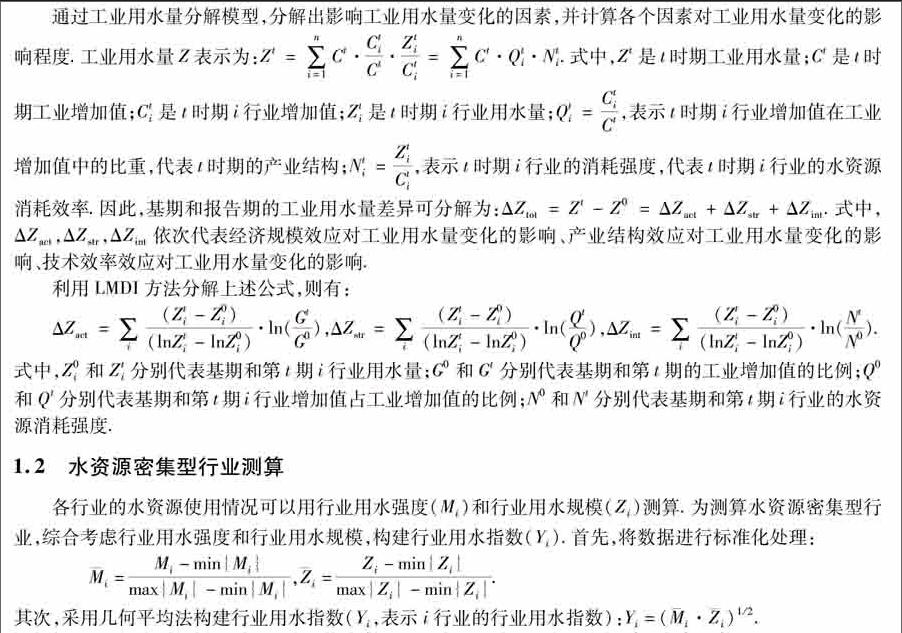山东省工业经济增长的水资源效应及时空演变分析
2016-03-01吴欣颖任建兰程钰
吴欣颖 任建兰 程钰



摘 要 利用LMDI分解模型分析1996—2013年山东省工业用水量的经济规模效应、产业结构效应和技术效率效应,探究山东省工业用水强度时空演变格局,得出以下结论:(1)近17年来,山东省行业增加值和行业用水量持续增长,而单位行业增加值用水量持续下降,降幅达9040%;(2)经济规模效应是工业用水量增加的主要原因,产业结构效应的作用较小,技术效率效应是抑制工业用水量增加的主要原因;(3)石油加工及炼焦业、医药制造业等7大行业是山东省水资源密集型行业;(4)1996—2013年,山东省工业用水强度一直呈下降趋势,但空间分异格局特征明显,基本呈现东部沿海偏低、西南地区偏高的特点.最后从结构调整、政策体系以及空间差异等视角提出应对措施.
关键词 水资源;工业经济;时空演变;山东省;LMDI分解模型
中图分类号 F427 文献标识码 A 文章编号 1000-2537(2015)04-0007-06
Abstract Economic scale effect, industrial structure effects and technical efficiency effects of water consumption were studied, and spatial-temporal evolution of industrial water intensity in Shandong Province was explored by LMDI decomposition model in 1996—2013. The research draws the following conclusions. Value added of the industry and water consumption continues to grow, water consumption per unit industrial added value continues to decline, a decline of up to 9040%, in Shandong Province during the recent 17 years. Economic scale effect is the main reason for the increase in industrial water consumption; industrial structure effects play a smaller role in industrial water consumption; technical efficiency effect is the main reason for reducing industrial water consumption. Petroleum processing and coking industry, pharmaceutical manufacturing industry and so on are the 7 largest resource industries in Shandong Province; Industrial water intensity of Shandong Province shows downward trend in 1996—2013. But the pattern of spatial variation characteristics significantly with the eastern coastal low and the southwest high. Finally, several suggestions were proposed in the aspects of structural adjustment, the policy system and spatial difference.
Key words water resources; industrial economy; spatial-temporal evolution; Shandong Province; LMDI decomposition model
水是自然界最基本的构成要素,是人类生存、经济建设和社会发展的基础性自然资源和战略性经济资源,是人类文明建设中最为关键的因素.然而,近年来由于工业经济规模持续增长使得水资源短缺和水资源污染问题成为影响区域可持续发展的障碍性因素.2012年,国务院印发《国务院关于实行最严格水资源管理制度的意见》,明确要求:到2015年,全国用水总量力争控制在635 km3以内,万元工业增加值用水量比2010年下降30%以上.2013年,我国用水量为618.34 km3,其中工业用水量为140.64 km3,约占全国总用水量的22.74%,我国用水总量控制形势严峻.同年,我国人均水资源占有量为2 059.70 m3/人,约为世界人均水平的28%,是全球13个人均水资源占有量最少的国家之一.我国年平均缺水量高达50 km3以上,水资源供需矛盾突出.山东省是我国工业大省,产业结构偏向重工业化.2013年山东省工业用水量达2886 km3,人均用水量为224.48 m3/人,人均水资源量约为300.45 m3/人.按照国际标准,人均水资源少于500 m3/人的地区为极度缺水地区.因此,山东省水资源供需矛盾尤为明显.
当前对于工业经济增长与水资源关系研究体现在以下3方面:①研究尺度方面,美国、日本和荷兰等发达国家是研究主力[1],大部分对水资源的研究归入可持续发展的范畴[2-3].我国主要研究全国重点城市、工业区和各省级行政区[4-14],主要集中在北方地区;②研究视角集中于工业用水量主要影响因素[4,14-15]、工业用水效率[5-7,12,16]、工业用水与经济发展[17]等方面,工业总产值、工业规模和工业制成品出口额是影响我国工业用水量的主要原因;而效率变化率和水价是影响我国工业用水效率的主要因素;③研究方法主要是计量方法,利用数据分析预测[18-19],少部分研究采用空间自相关方法[12].以上研究存在定量研究少、空间研究少特别是时间演化过程和空间分异格局研究不能结合的问题.本文探讨山东省近20年工业经济增长与水资源关系,对山东省水资源可持续利用提供借鉴.
